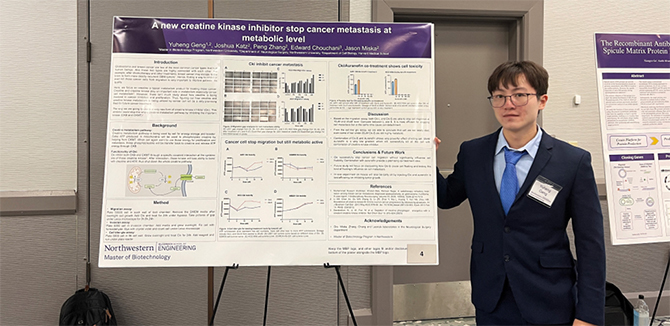Speaking to a Different Kind of Audience
MBP’s Fall Research Symposium gave students the chance to sharpen their oral presentation skills while talking to leaders within the biotech industry.

It’s one thing for students to present their work to peers. But how about to a group of industry leaders from the field where they want to make their mark?
That was exactly what students in Northwestern Engineering's Master of Biotechnology Program (MBP) faced recently at the Fall Research Symposium.
Each year, MBP students have the opportunity to present their research findings to the program’s Industrial Advisory Board (IAB). That board is made up of leaders in the biotech industry who are tasked with ensuring what MBP students learn remains aligned with actual business needs.
So how was the transition from presenting their research to their fellow students to showcasing their communication skills to everyone from the director of research and development at Abbott to the executive director for cell based sciences, analytical research, and development at Merck?
“Nerve-wracking," joked Viktor Maciag (MBP ‘24), "but rewarding.”
Maciag presented his research with startup Clever Carnivore on stem cell cultures for laboratory grown meat. Maciag, Brendan Hood (MBP ‘24), and Yuheng Geng (MBP ‘24) were named the top three finishers for their oral presentations to the IAB members. Each was honored for his 10-minute talk and responses to five minutes of questions from board members.
The research symposium is divided into two parts – the oral presentation and a poster presentation. It is facilitated by MBP faculty and is purposefully designed to put students in meaningful and challenging situations where they must showcase not only their work but their ability to communicate its importance.
“The biggest thing I took away from the symposium experience was how to better present research and scientific information to an audience who may not necessarily be familiar with what is being presented,” Hood said. “This can be a real struggle when it comes to something you’ve spent a ton of time delving into and then trying to translate that to an audience who may be familiar with science but not the niche subject you’re presenting on.”
Hood’s work looked at the role a specific type of tiny, misfolded protein cluster plays in the progression of Alzheimer’s disease. These clusters, called Amyloid Beta Oligomers, became a common term and topic for Hood but aren’t exactly watercooler talk for most – even those in the biotech community.
Hood said he felt his presentation was well received because of a device more common to a classroom than a scientific laboratory – storytelling. By laying out a clear narrative, Hood said, he was able to take the judges on a journey that bridged the gap from unfamiliarity to understanding.
Geng applied a similar approach to his presentation, which explored the potential of inhibiting creatine kinase for future cancer treatments.
"When presenting in front of an audience, it’s best to keep the knowledge simple and clearly highlight key points for them to easily understand," Geng said.
Maciag appreciated being able to present his findings because of the lessons he learned — not just in the lab, but through the presentation itself.
“Presentation skills are a must in any professional setting,” he said. “Practicing presenting and giving presentations to folks far more experienced than you, as well as learning how to organize data well in a succinct manner, is important.”
Hood said the value in participating in the symposium goes beyond the presentations themselves.
“The IAB is made up of a plethora of individuals with tons of different experiences throughout the biotech field,” he said. “Being able to not only get feedback from them when it comes to presenting scientific findings but also to be able to network and connect with them provided tons to learn from.”

